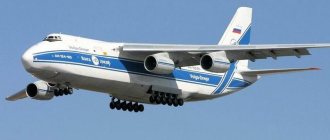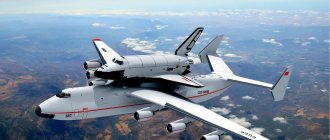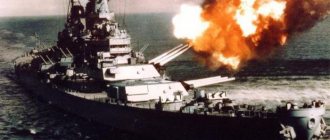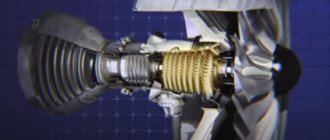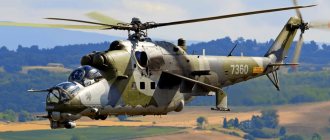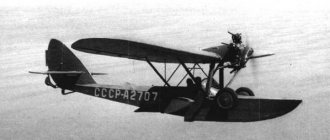The advantage of airplanes over all other modes of transport is speed and mobility. And also safety, cars are hundreds of times more likely to get into accidents than airplanes. All these qualities are especially important for military aviation. Large carrying capacity somehow fades into second place. But in modern conditions of warfare, this quality of aviation was not in last place.
This became especially clear during the Great Patriotic War, when fast delivery of large cargo over long distances was urgently required, but the aircraft necessary for this were not enough. So the idea arose to create equipment that could do this; the An-22 aircraft became such a machine.
History of creation
After the war, the creation of a transport aircraft became especially important, as foreign competitors successfully created such types of transport and put them into operation. It was necessary to keep up, and the development of military equipment required the presence of heavy-duty aircraft.
The Soviet government set the designers the task of creating a transport aircraft that could deliver large cargo, for example, ballistic missiles or heavy military equipment, to the right place.
The purposeful work of the Soviet leadership led to the launch of a project called product 100 in 1958. It went through several stages and led to the development and creation of the desired aircraft.
- The design of such an aircraft became possible due to the fact that the NK-12 engine was created for the Tu-95 aircraft, which will become the basis for the An 22 Antey.
- In order to develop a new cargo air transport, in 1958 a group was created at the Antonov Design Bureau under the direction of A. Belolipetsky. The design brief set the following goal: to create a transport aircraft with a payload capacity of up to fifty tons. And he could land both on a regular runway and on the ground.
- By 1961, a mock-up of the aircraft was prepared, and in 1964 the first two prototypes were ready, which were to be tested and then put into operation.
- It was in 1964, when prototypes were already ready and testing began, that the An-22 aircraft received its other name, “Antey”. With him he went down in history.
- By 1967, after all the necessary tests, the aircraft entered service with the army, having established itself as a reliable means of delivering large cargo throughout almost the entire planet.
Serial production of "Antey" was established at the Tashkent aircraft plant. In 1967, the aircraft was shown at the Paris Air Show. An interesting fact: the entire Soviet exposition of this salon was transported on the An 22, although there were no demonstration flights with its participation this year.
It is also important to note that the aircraft appeared at the air show back in 1965, and even then made an indelible impression on everyone who saw it.
At that time it was the largest aircraft in the world.
In the Soviet Union itself, the general public saw the new transport aircraft at an air parade in Domodedovo on July 9, 1967. Two years later, in 1969, the An-22 made demonstration flights at the Paris Air Show. Moreover, at an altitude of 20 meters with two engines turned off. To say that he created a sensation there would be like saying nothing. At that time it was the largest transport aircraft in the world.
In the 1970s, Antey was actively used not so much by the military, but more for purely civilian purposes. Especially for delivering goods to Siberia and the Far North. In harsh weather conditions the aircraft performed at its best. The An 22 delivered equipment for oil rigs, construction equipment and even diesel power plants. Without it, the development of oil fields and diamond mining would have been impossible.
A total of 68 aircraft were produced during the 1970s; at the end of the 70s, production of the An-22 Antey was discontinued, as priority was given to a new aircraft of the same type, the Il-76. A turbojet analogue of a cargo transporter, it was superior to its counterpart in many respects, but it wasn't perfect either.
An-22 Antey - video
The first flight took place in 1965. 68 copies were serially produced, including two for strength testing. Used in the USSR Air Force, continues to be used in the Russian Air Force and Ukrainian aviation.
History of creation
Work on the An-22 aircraft (at that time “product 100”) began in 1960, headed by Deputy Chief Designer A. Ya. Belolipetsky. The cargo compartment was designed taking into account all military and civilian equipment weighing up to 50 tons available in the country. To reduce the heeling moment when the steering wheel was deflected, a two-fin tail was used. To enable operation from unpaved airfields, a multi-wheeled chassis with low-pressure pneumatics is used. The aircraft was planned to be equipped with four NK-12MV turboprop engines with AB-90 propellers with a diameter of 6.2 m.
In August 1961, a meeting of the mock-up commission for “product 100” was held. In 1963, production began on the first prototype, which was ready by the summer of 1964. On August 18, 1964, the first vehicle was handed over for flight testing. From that moment on, the new aircraft received the designation An-22 “Antey”. Due to the fact that the new propellers had not yet been sufficiently tested, the first aircraft was equipped with AB-60 propellers.
The An-22 made its first flight on February 27, 1965 from the airfield of the Kyiv aircraft plant Svyatoshino to the military airfield in the city of Uzin, Kyiv region. In the cockpit there was a crew consisting of commander Yu. V. Kurlin, co-pilot V. I. Tersky, navigator P. V. Koshkin, flight engineer V. M. Vorotnikov, flight electrician M. P. Rachenko, flight radio operator N. F. Drobyshev and presenter testing engineer V.N. Shatalov. The first public demonstration of the aircraft took place on June 15, 1965 at the Le Bourget Air Show.
Leading An-22 testers:
— Major General of Aviation S. G. Dedukh — Colonel-Engineer I. M. Pankov — Colonel-Engineer M. P. Ishcheev
Serial production of the An-22 was organized at the Tashkent aircraft plant. From November 1965 to January 1976, 66 Anteevs were produced, of which 22 were in the An-22A variant. The first Anteis began to arrive in the Air Force in January 1969. Production of the An-22 was discontinued in favor of expanding production of the then newest turbojet military transport aircraft, the Il-76, which was deployed at the Tashkent aircraft plant in the early 70s. Turboprop engines began to be considered obsolete and more difficult to maintain and repair.
Name
The giant An-22 military transport aircraft was named "Antey" in honor of the invincible giant from Greek mythology - Antaeus. Antaeus was the son of the earth goddess Gaia and could endlessly receive new strength from contact with the earth and therefore never got tired. However, the name “Antheus” for an airplane is not very good, since when Hercules fought the giant Antaeus and lifted him off the ground, lifting him high into the air, Antaeus’ strength quickly dried up. Thanks to this, Hercules was able to kill him. The ambiguity of this situation also lay in the fact that the Greek name Hercules or Hercules - in the ancient Roman adaptation - was the name given to the American military transport aircraft Lockheed C-130 Hercules. Academician I.N. Fridlyander, who took part in the creation of the aircraft, in his memoirs explained the name for the aircraft by the fact that the aircraft acquired energy from the ground, filling its tanks with fuel.
Description
The entire history of mankind consists for the most part of wars. Maintaining them stimulates the development of technical progress, and in the field of aircraft construction this is especially significant.
The history of the creation of the An-22 Antey aircraft is no exception: it was initially developed for the needs of the military, but after launching into mass production it carried out a lot of transportation of purely civilian cargo. And for the most part it was used for peaceful purposes.
This powerful cargo carrier, capable of delivering any military equipment to any point on the planet, also supplied equipment to geologists, oil workers, and residents of the Far North. The description of this aircraft emphasizes the scale and power of such an aircraft.
- "Antey" is an all-metal monoplane.
- The aircraft has a wide fuselage.
- The tail part is sloping upward, it has a large hatch through which it is possible to load even tanks and ballistic missiles and their elements.
- The wing is located in the upper part, it has slotted flaps.
- Chassis of three racks. The front pillar is rotating, has two wheels 1450*580, one on each side. The rear two main supports have trolleys of 6 wheels, each measuring 1750*730mm, and their height is greater than the average height of a person.
- Due to the fact that it is possible to regulate the pressure in the wheel chambers, the AN 22 aircraft can, if necessary, land on the ground.
- The crew of this air transport consists of 6 people.
- The passenger compartment is designed for 29 people, the passenger compartment is located in front of the cargo compartment.
The plane received the not very successful name "Anteus" in honor of the hero of Greek mythology, who received his powers from his mother, the goddess Gaia, but only as long as he was in contact with the earth. As you know, Hercules defeated Antaeus by lifting him above the ground, thus depriving him of his strength. It is interesting that the analogue of “Antheus”, an American military transporter, is called “Hercules”. It turns out that symbolically the American “Hercules” always defeats our domestic “Antheus”.
The Antea set 40 world records. For the first time, a load weighing 88 tons was lifted to a height of 6600 meters, as well as a load weighing 100 tons to a height of 7800 meters. It flew with a cargo weighing 40 tons over a distance of 5,500 kilometers. And this is the only transport aircraft in the world that can land on a dirt runway.
Many of the aircraft's records are still behind it.
As a transport aircraft, the Antey had no weapons on board, but the Afghan war made some adjustments to the equipment of the aircraft. To protect the ship from MANPADS, the aircraft was equipped with automatic jamming devices (AMA). They consisted of checkers that, when burned, formed false thermal targets. In total, 10 aircraft flying to Afghanistan were equipped with such installations.
But they could not completely protect the vehicles, so they tried to use the An in Afghanistan as little as possible.
Start of serial production, problem solving
At the end of January 1966, the Tashkent Aviation Plant produced the first production model, which immediately took to the skies.
Oddly enough, official state tests began only the following year. And only in 1968, more than ten years after the start of development, the Soviet army began to be equipped with these machines. Officially, aircraft of this model enter service with the Military Transport Aviation after another twelve months. And in 1971, two regiments were completely saturated with Anteys. With their advent, the Soviet army immediately got rid of almost all the problems associated with transporting large amounts of cargo and personnel over long distances. These wonderful aircraft could transport almost 90% of all vehicles available to infantry and armored forces, with the exception of only super-heavy armored vehicles.
Design Features
The An 22 Antey is a four-engine turboprop high-wing aircraft. The design of this high-wing aircraft has a two-fin tail, which makes it possible to easily control a powerful aircraft.
The An-22 aircraft has a number of design features that are not inherent in it.
Fuselage
It consists of frames, as well as beams and stringers, which form, as it were, the skeleton of the machine itself. The fuselage can be divided into the following parts:
- the crew cabin, which consists of two decks: the navigator is located on the lower deck; the pilots and flight attendant are located on the upper deck;
- passenger cabin of 3 cockpits (two on the lower deck, one on the upper);
- the tail compartment is the largest 32.7 * 4.4 * 4.4 m, cargo, the floor in it is made of titanium alloy and this compartment is designed to receive various cargoes that are received through the tail section;
All of the above compartments are sealed, but the tail end is ordinary, without any sealing. Fuselage diameter 6 m.
Wings
The design of the wing uses the technology of dividing into seven parts, i.e. four middle ones, two more detachable ones and a center section. The rest of the wing can be characterized as follows:
- trapezoidal shape;
- caisson type;
- there is an aileron on the rear of the removable edge;
- the span of the entire edge of the detachable part is occupied by a double-slot flap.
There are three spars in the middle parts and center section, and two in the detachable part. The engines are located in the middle part of the wing.
Preliminary tests
What’s interesting: during the development process, radio-controlled aircraft models were constantly used, on which the main driving characteristics of the future aircraft were tested, and aerodynamic parameters were studied. A full-fledged AN-22 model was ready by mid-autumn 1961. It was approved by the commission, after which the first working prototype began to be assembled in the winter of the same year. Two aircraft were assembled: one was intended for static tests, the second for flight tests. The first flying prototype left the hangar only in mid-1964.
The side number of the vehicle is 46191, the power plant is NK-12MV, the propellers used the AB-60 model. What is characteristic: flight tests were carried out immediately two years later than the planned deadline. The AN-22 first flew in the air only in 1967. The first object, intended for static tests, passed all planned tests from 1964 to 1966.
Power plants
Their main indicators are shown in the table.
| Element | Name and indicators |
| Turboprop engine | NK – 12MA |
| Screw | AB – 90 |
| Starter | Sun – 12 |
| Number of fuel tanks | 20 |
| Tank capacity | 127619 l |
The screws are 6.2 m in diameter, coaxial, one rotates clockwise and the other counterclockwise. The first prototypes of the aircraft used AB-60 propellers.
Chassis
The peculiarities of the An 22 chassis mechanism are that they can be extended or retracted not only simultaneously, but also separately. During testing, it was the landing gear that was the weakest point of the aircraft.
The landing gear was partially destroyed, or some of their elements failed.
Military transport aircraft. Development.
In parallel with the production of the An-2 in various versions, the design bureau was developing a new generation aircraft. Improving the design elements of the An-2 was aimed at creating the latest cargo aircraft. The designers of Antonov's bureau worked out the aerodynamic characteristics, checked the parameters of its stability and controllability.
The An-22, another name Antey, surpassed all its analogues in the world in its flight characteristics, payload capacity and elegance of design. The creation of a unique machine required the use of new high technologies, instruments and equipment. The development of new aircraft manufacturing technologies went parallel to the design process of the An-22. Many installations were created directly during the aircraft assembly process.
Loading and unloading facilities
The main purpose of the aircraft is to transport cargo, and transport aviation must have sophisticated loading and unloading mechanisms, which are fully available on the An 22 Antey.
- Gangway ramp. A special mechanism in the tail of the aircraft, which allows you to quickly and safely load large cargo. The ramp is lowered to the ground and along it trucks or equipment can enter the aircraft. And during the landing, the ramp, open during flight, facilitates the landing process.
- Monorail electric hoists. Their load capacity is 2500 kg. They can move cargo along the fuselage, picking it up from the ground and delivering it to the desired location inside the aircraft.
It is possible to transport large loads under the wing on a suspension. In general, the An 22 can land 22 tons of weapons or equipment.
Photo of An-22 Antey
An-22 of Ukrainian aviation
Cabin of An-22 Antey
Workplace of the flight radio operator of the An-22 "Antey"
Workplace of the flight engineer of the An-22 "Antey"
Cargo cabin of the An-22 aircraft
Aircraft technical characteristics
All technical characteristics are summarized in a special table, including flight characteristics.
| Parameter name | Index |
| Length | 57.31 m |
| Height | 12.53 m |
| Weight | 118727 kg |
| Wing span | 64.40 m |
| Ceiling height | 9000 m |
| Flight speed | 650 km/h |
| Range of flight | 5225 km |
| Length required for take-off run | 1460 m |
| Crew | 5 – 7 people |
| Load capacity | operational 40 tons, maximum 60 tons |
The Antey's dimensions allow it to transport up to 700 people or 4 infantry fighting vehicles, or a tank. As well as any front-line aircraft or helicopter. That is, with the help of this transport aircraft, you can quickly transfer a regiment of soldiers with equipment and weapons to any point in the country.
From heavy weapons, the aircraft can take on board any equipment from artillery installations to self-propelled guns.
Other tasks
In addition, if necessary, cargo and equipment weighing up to 20 tons had to be dropped from the aircraft. Therefore, the calculated diameter of the body alone was equal to six meters, which automatically made the aircraft a world record holder in its class. And further. Immediately, engineers were faced with the need to create new turboprop engines, since all existing models simply could not provide the required thrust indicators.
Of course, we had to overcome a lot of difficulties with regard to the landing gear: an aircraft of such mass and dimensions, which was supposed to land on ground runways, simply had to have ultra-reliable landing mechanics. Because of this, each AN-22 transport aircraft received three wheeled bogies and a powerful front strut. In total, the plane had 14 wheels. The peculiarity of the front section of the chassis was the large-diameter wheels, which ensured that the huge machine could turn on the runway.
Modifications
The An 22 is not the only development of the Antonov Design Bureau designers. There were also modifications of this aircraft, most of them remained at the project stage, but there were also successful implementations that served people.
- An 22 amphibian. Simultaneously with the development of the transport aircraft, a project for an amphibious transport aircraft was created on the basis of Product 100. Such a plane could land on water and take off from water. This gave a great advantage when landing in the absence of an airfield or for supplying submarines with cargo. There were two versions of the amphibian with floats on the fuselage and under the wing, retractable inside. It was supposed to use a special hydraulic chassis - a water ski in the bow, and two hydrofoils in the middle. The project remained at the mock-up stage and was never translated into reality.
- An 22PZ. The so-called "carrier". A specially modified “Antey” for moving large parts onto the external sling for the An 225 “Mriya” and An 124 “Ruslan” aircraft. The modification consisted of installing suspensions on the center section and two more suspensions on the fuselage behind the center section. "Carrier" from 1980 to 1988 made 100 flights with cargo from Tashkent to Kyiv and Ulyanovsk.
- An 22PS. The aircraft project, which was discussed in 1967, remained on paper. It was assumed that the main purpose of this An would be search and rescue operations. There was an urgent need for such an aircraft, but it never came to fruition.
- An 22PLO. Test versions of aircraft with a nuclear power plant. This made it possible to significantly increase the flight range (up to 27,500 km). A supply of fuel was required only for takeoff and landing, and during the flight the nuclear reactor was turned on (it was located in the fuselage). This development remained at the prototype research stage.
- An 22Sh. In this project, to transport large cargo, such as rocket stages, it was proposed to expand the fuselage behind the center section to 9.6 m.
- An 22R. At the end of 1969, the idea arose to use the An as a platform for launching ballistic missiles, but it was soon abandoned without starting development of the project.
All modifications of the transport aircraft prove the versatility of the An 22 when performing various tasks for transporting goods over long distances. And although the production of aircraft of this type has long ceased, this does not mean that its resource has been completely exhausted.
It is possible to return to service under the name An 22 - 100.
Requirements set out in the technical specifications
The project involved the creation of a universal aircraft designed to transport cargo weighing up to 50 tons.
Particular emphasis was placed on the fact that the machine had to “be able” to land not only on hard, artificial runways, but also on simple dirt clearings. In addition, it was possible to land even on strips covered with snow and ice. In this case, the aircraft had to operate in conjunction with Mi-12 helicopters, which, having picked up cargo from such strips, would deliver them to areas completely inaccessible to aircraft. In general, the following requirements were initially presented to the project:
- Possibility of transporting intercontinental ballistic missiles.
- Transportation of engineering and military equipment: armored and non-armored.
- Air shipment of containers of any size with cargo for various purposes.
- oversized and large cargo.
